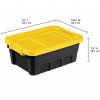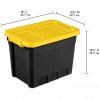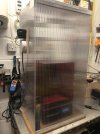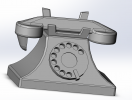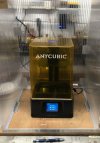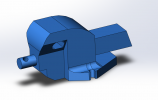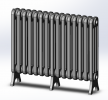Big Train James
Western Thunderer
Simon,
It appears that the software/printer compatibility issue has been put to rest now, but in looking back I find it interesting how often people seem to think it was an Elegoo issue, rather than a Chitu Systems issue. The reality is that any printer employing the latest Chitu boards, and there are a lot of them from many of the common manufacturers, would have faced the same obstacle with the print files. I have no idea why Elegoo, and the Mars 3 in particular, seem to be the printer most often associated with the problem. Perhaps the Mars 3 was the first newly released printer with the locked board implementation? Neither here nor there anymore, hopefully. I am about to download Lychee and give it twirl, so I will confirm that the files work with the Mars 3.
I'll be curious to see if the yearly cost for Chitubox Pro drops in the future. The board locking created a proprietary situation, without it I have a hard time imagining users paying $169 per year when Lychee Pro can be had for $73 per year instead. It's interesting to note the Lychee Pro yearly price. That figure is more than double what it was a bit over a year ago. Anyway, I'll give Lychee a try in one form or another.
Rob,
My Chitubox Pro says what it is in the top left corner of the window. As to utilization, I took another look last night at the specs for the Pro version versus the free version. There is a great deal more capability with the Pro version, but an awful lot of it is extra bells and whistles that I most likely won't ever need to use. But it is certainly a "your mileage may vary" situation, I happen to be in a position where I don't necessary have need for the extra features.
My primary software for modeling is Autocad, I do a small amount with Rhino (should do more). I am planning to migrate some work to Solidworks in the near future, as I'm looking for more robust surface modeling capabilities. Whether Autocad or Solidworks, any 3d model I export for printing is a solid model rather than a surface model. As a result, it is unusual for me to encounter repair issues like reversed normals, holes, extra faces, etc, those are more often found in surface models.
Chitubox Pro supports a pretty long list of file types from various 3d modeling software, so that models can be imported in their native formats. I don't benefit much from this, since I have access to software that allows me to export stl files, and I only use one or two softwares anyway. I will never take advantage of the model prep commands, as my philosophy is to do modeling in a modeling program, where it should happen. A lot of the other pro features might be more worthwhile to hard(er)core or commercial users, while some of them are nice I probably won't have much reason to use them.
In short, there are a lot of features that might appeal to other users, but don't have much impact on how I personally use the program. Which is fair enough. Also, it should be noted that the Pro version of Lychee is much the same. I will trial the Pro version of Lychee, and then decide if I need the Pro version of either software.
What I suspect will happen, is that I will discover one or two commands or utilities that I find exceptionally useful, but are not available in the free version. Then I will eventually give in and pay for the pro version just to access those particular features. This happened to me years ago with early versions of Autocad, before real-time zoom and pan were available with scroll wheel mice. I used the Zoom Dynamic command heavily to navigate around drawings, as I could use it transparently while in other commands. When I looked at getting Autocad LT because of the lower cost, I discovered that it didn't support Zoom Dynamic. It was such an integral part of how I used Autocad, that I paid for the full version so I had access to it.
Jim
It appears that the software/printer compatibility issue has been put to rest now, but in looking back I find it interesting how often people seem to think it was an Elegoo issue, rather than a Chitu Systems issue. The reality is that any printer employing the latest Chitu boards, and there are a lot of them from many of the common manufacturers, would have faced the same obstacle with the print files. I have no idea why Elegoo, and the Mars 3 in particular, seem to be the printer most often associated with the problem. Perhaps the Mars 3 was the first newly released printer with the locked board implementation? Neither here nor there anymore, hopefully. I am about to download Lychee and give it twirl, so I will confirm that the files work with the Mars 3.
I'll be curious to see if the yearly cost for Chitubox Pro drops in the future. The board locking created a proprietary situation, without it I have a hard time imagining users paying $169 per year when Lychee Pro can be had for $73 per year instead. It's interesting to note the Lychee Pro yearly price. That figure is more than double what it was a bit over a year ago. Anyway, I'll give Lychee a try in one form or another.
Rob,
My Chitubox Pro says what it is in the top left corner of the window. As to utilization, I took another look last night at the specs for the Pro version versus the free version. There is a great deal more capability with the Pro version, but an awful lot of it is extra bells and whistles that I most likely won't ever need to use. But it is certainly a "your mileage may vary" situation, I happen to be in a position where I don't necessary have need for the extra features.
My primary software for modeling is Autocad, I do a small amount with Rhino (should do more). I am planning to migrate some work to Solidworks in the near future, as I'm looking for more robust surface modeling capabilities. Whether Autocad or Solidworks, any 3d model I export for printing is a solid model rather than a surface model. As a result, it is unusual for me to encounter repair issues like reversed normals, holes, extra faces, etc, those are more often found in surface models.
Chitubox Pro supports a pretty long list of file types from various 3d modeling software, so that models can be imported in their native formats. I don't benefit much from this, since I have access to software that allows me to export stl files, and I only use one or two softwares anyway. I will never take advantage of the model prep commands, as my philosophy is to do modeling in a modeling program, where it should happen. A lot of the other pro features might be more worthwhile to hard(er)core or commercial users, while some of them are nice I probably won't have much reason to use them.
In short, there are a lot of features that might appeal to other users, but don't have much impact on how I personally use the program. Which is fair enough. Also, it should be noted that the Pro version of Lychee is much the same. I will trial the Pro version of Lychee, and then decide if I need the Pro version of either software.
What I suspect will happen, is that I will discover one or two commands or utilities that I find exceptionally useful, but are not available in the free version. Then I will eventually give in and pay for the pro version just to access those particular features. This happened to me years ago with early versions of Autocad, before real-time zoom and pan were available with scroll wheel mice. I used the Zoom Dynamic command heavily to navigate around drawings, as I could use it transparently while in other commands. When I looked at getting Autocad LT because of the lower cost, I discovered that it didn't support Zoom Dynamic. It was such an integral part of how I used Autocad, that I paid for the full version so I had access to it.

Jim

 -ubox", which seems entirely appropriate in my opinion.
-ubox", which seems entirely appropriate in my opinion. 

 I still appreciate everybody's willingness to help though.
I still appreciate everybody's willingness to help though.
